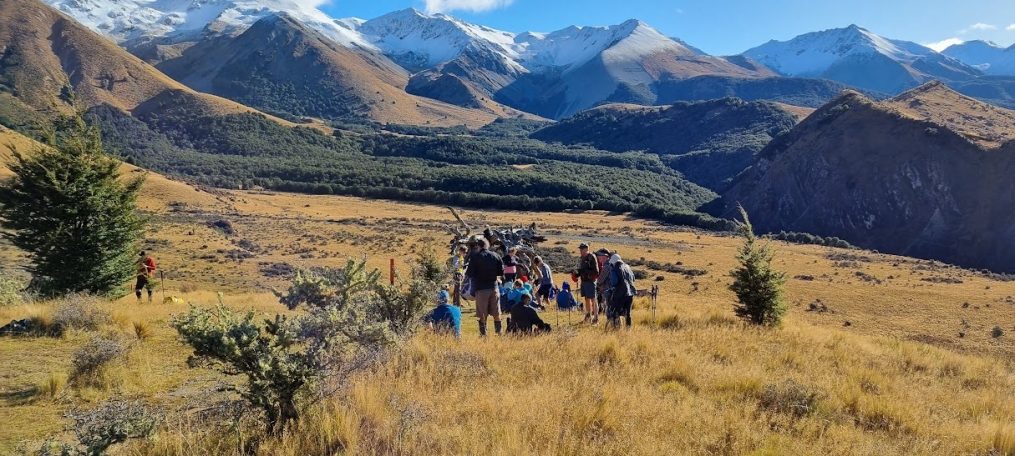| Leader | Mentor | Understudy | Tail Ender | |
| Standards | Chris S | Jan Br | Kay | Ailsa |
| Alternates | Ali | Norma | Linley | Tessa |
Distance 13km (approx); duration 4hrs 30min; vertical ascent 504m
It was a lovely fresh 10 degree morning with an almost autumnal feel when 47 trampers including visitors Judy S and Andrea (Linley’s daughter) boarded the bus for Little River with first time BTC driver Geoff. Shirley and Dave shared the joy of their new grandson Quinn with a generous chocolate shout. Update from last week’s new bidet owner – it’s not yet installed so no christening to report.
In one of the paddocks stood the statue of a large white cattle beast. One of our trampers when driving to Akaroa on Monday had witnessed a large white beast upside down, legs in the air surrounded by several men. She found it quite upsetting to think it must have died and was waiting to be lowered into a trench. Now standing proudly on a rock. On our return trip a sign revealed more, Silverstream Charolais and Herefords is a stud operation. This set us googling – Silverstream Evolution – probably the best bull ever bred – 50 daughters in the herd – semen to die for, x-factor quality.
After a slow journey with many traffic cones and a traffic light 32 Standards set off at 1020 from the Hilltop Tavern car park. Through a paddock of friendly cows and over a stile soon had us heading uphill in the Montgomery Reserve which found us posing for the group photo at the massive forked tōtara tree, supposedly 2000 years old. Tōtara trees are slow growing and can live for 1000 years so this one has obviously missed the memo. The forest is stunning with tōtara and mataī and the contrasting orange papery bark of the fuchsia. The monolithic rock steps – slippery in the wet, have not got any closer together so give a whole new meaning to stretching the legs. The track climbs sharply through regenerating bush and a gap in the bluffs to reach open space on the top of the hill and morning tea in the sunshine at 1120.
The next section involves walking through tussocks and bracken some almost waist high and climbing several hills while viewing the sparkling waters of Pigeon Bay to the north. The hillsides are littered with the carcasses of silver stumps and haunting skeleton trees. It is easy to be transported back in time to imagine the peninsula when two thirds was covered by dense podocarp forest of tōtara and mataī and filled with birdsong. The forests were ruthlessly cleared by both fires and felling to clear the land for dairying and provide timber to build Christchurch. In 40 years the forest and native birds had disappeared. Trees came down and cheese production went up. In 1857 there were 18 dairies on the peninsula.
The perfect lunch spot was reached at 1305 with plenty of stumps and logs for resting on with magnificent regenerating bush at our backs and the blue of the bays below. From different positions on the track you can view Pigeon Bay, Lake Ellesmere, Lake Forsyth and Akaroa. The Alternates who had commenced their hike at the junction of Pigeon Bay and Pettigrews Road and hiked uphill though Whatarangi and Sinclair Reserves were looking very contented at the end of their lunch break as we arrived. No shortage of space here and a log for everyone.
Chris our leader led us ably on our descent through farmland on very slippery grasses with several boggy areas and a timely warning to watch out for the tree nettle ongaonga. It has a nasty sting which doesn’t fade quickly. There were numerous slides, a leg caught in the wire of a fence when climbing through (suggest a yoga retreat to improve flexibility) and an unfortunate unplanned swim at the last river crossing but no serious injuries. We reached the bus along the road in Cooptown at 1520, five minutes after the Alternates.
It had been perfect tramping weather with sunshine and cloud but no rain, birdsong in the bush, cow pats ++++, haunting forest, regenerating bush and bay views to die for. It was after 1700 when the bus arrived back in Bishopdale all feeling in good spirits after a great tramp.
Txt by Kate W










